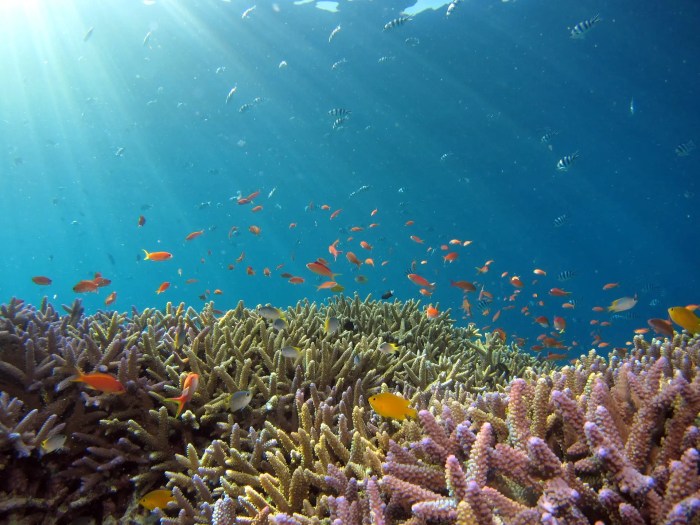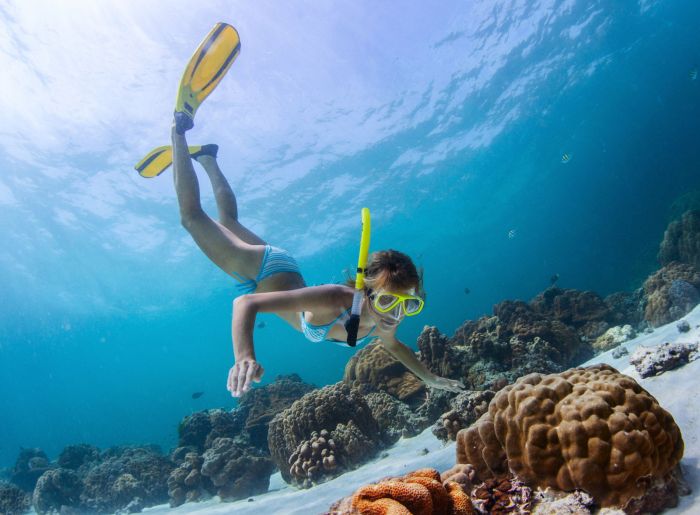
Embark on an unforgettable journey beneath the waves of the Caribbean Sea. This guide unveils the breathtaking underwater world, from vibrant coral reefs teeming with life to the thrill of encountering diverse marine species. We’ll explore the best locations for snorkeling, essential equipment and safety tips, and unique experiences that will elevate your Caribbean adventure beyond the ordinary.
Discover the top snorkeling spots across various Caribbean islands, catering to all skill levels. Learn how to select and use snorkeling gear effectively, ensuring a safe and enjoyable experience. We’ll also delve into unique snorkeling activities, like night dives and encounters with specific marine animals, alongside a comprehensive look at other Caribbean activities and how to plan your budget-friendly trip.
Best Caribbean Locations for Snorkeling
The Caribbean Sea boasts an unparalleled array of vibrant coral reefs and diverse marine life, making it a snorkeler’s paradise. Choosing the best location depends on your priorities, from the specific marine species you hope to encounter to the level of snorkeling experience you possess. This section highlights five exceptional Caribbean islands, each offering unique underwater experiences.
Top Five Caribbean Islands for Snorkeling
The following table details five prime Caribbean islands for snorkeling, considering their unique underwater features, marine life, water clarity, and accessibility for various skill levels. The ideal time to visit is also considered, bearing in mind that weather conditions can be unpredictable.
| Island | Best Snorkeling Spots | Marine Life Highlights | Water Clarity |
|---|---|---|---|
| Grand Cayman, Cayman Islands | Stingray City, Smith Cove, Cemetery Beach | Stingrays (Stingray City), colorful reef fish, sea turtles, eagle rays | Exceptional; crystal-clear waters with high visibility |
| Bonaire, Netherlands Antilles | Hilma Hooker Wreck, 1000 Steps, Karpata | Diverse coral reefs, abundant fish life including angelfish, parrotfish, and sergeant majors, seahorses | Remarkably clear; known for its pristine waters |
| Cozumel, Mexico | Palatuluc Reef, Santa Rosa Wall, Colombia Reef | Large variety of reef fish, colorful corals, sea turtles, occasional sightings of larger pelagic species | Generally excellent; can vary slightly depending on location and weather |
| St. John, US Virgin Islands | Trunk Bay, Caneel Bay, Salt Pond Bay | Healthy coral reefs, diverse fish populations, sea turtles, occasional dolphin sightings | Good; generally clear with some variation depending on weather and location |
| Roatán, Honduras | West Bay, Sandy Bay, West End | Vibrant coral reefs, abundant fish life including colorful reef fish, eagle rays, and nurse sharks | Excellent; particularly clear in the shallower areas |
Ideal Snorkeling Times and Accessibility
Optimal snorkeling conditions generally occur during the drier months, typically from December to April, across most of the Caribbean. However, this can vary slightly depending on specific locations and weather patterns. It’s advisable to check local weather forecasts before planning your trip.Regarding accessibility, many snorkeling spots in these islands cater to all skill levels. Locations like Smith Cove in Grand Cayman and Trunk Bay in St.
John offer calm, shallow waters perfect for beginners. More experienced snorkelers might prefer challenging sites such as the Hilma Hooker Wreck in Bonaire or the Santa Rosa Wall in Cozumel, which often involve stronger currents. Always prioritize safety and choose locations appropriate for your experience level. Guidance from local tour operators is recommended for less experienced snorkelers.
Snorkeling Equipment and Safety
Snorkeling is a fantastic way to explore the vibrant underwater world of the Caribbean, but safety and proper equipment are paramount for an enjoyable and hazard-free experience. Understanding the function of your gear and following safety guidelines will significantly enhance your underwater adventure.Proper equipment selection and usage are crucial for a comfortable and safe snorkeling experience. Neglecting these aspects can lead to discomfort, exhaustion, and even dangerous situations.
This section details essential equipment and provides a step-by-step guide for its use, along with important safety tips for snorkelers of all experience levels.
Essential Snorkeling Equipment
Choosing the right snorkeling equipment is vital for a comfortable and safe experience. The following items are essential for every snorkeling trip:
- Snorkel: A snorkel is a tube that allows you to breathe while your face is submerged. Look for a snorkel with a comfortable mouthpiece, a splash guard to prevent water from entering, and a purge valve to easily clear any water that does get inside. The material should be durable and easy to clean.
- Mask: A properly fitting mask is crucial for clear underwater vision. Ensure a good seal around your eyes and nose to prevent water leakage. Consider a mask with tempered glass lenses for durability and clarity. A low-volume mask minimizes the amount of air you need to clear from the mask, reducing the effort required.
- Fins: Fins provide propulsion underwater, making it easier to explore and conserving energy. Choose fins that fit comfortably and securely. Open-heel fins, which are worn over your existing footwear, are often preferred for snorkeling, while full-foot fins offer a more snug fit. The fin material and design should provide sufficient propulsion without excessive fatigue.
- Life Vest or Buoyancy Aid (Optional but Recommended, especially for beginners): While not strictly necessary for strong swimmers in calm conditions, a life vest or buoyancy aid provides extra safety, especially for beginners or in areas with currents. It offers additional flotation and helps prevent exhaustion.
- Rash Guard or Swimsuit: A rash guard offers protection from the sun and potential abrasions from coral or rocks. A swimsuit provides comfortable movement in the water. Choose quick-drying materials for added comfort.
Using Snorkeling Equipment Properly
Proper use of your snorkeling equipment is essential for a safe and enjoyable experience. Follow these steps:
- Mask Preparation: Before entering the water, ensure your mask fits snugly and doesn’t leak. Adjust the strap for a comfortable and secure fit. Wet the inside of the mask with saliva or water to create a better seal and prevent fogging.
- Snorkel Preparation: Check that the mouthpiece is comfortable and the purge valve functions correctly. Ensure the snorkel is securely attached to your mask if it has a strap.
- Entering the Water: Enter the water slowly and calmly, keeping your mask and snorkel in place. Submerge your face gently, ensuring your snorkel is above the water’s surface.
- Breathing Technique: Breathe through your mouth using the snorkel, keeping your breathing slow and steady. Exhale gently through your mouth or nose to clear any water from the snorkel.
- Finning Technique: Use a steady, fluid finning motion, starting from your hips and not your knees. Avoid kicking too hard or rapidly, as this can cause fatigue and disorientation.
- Exiting the Water: When you are ready to exit, remove your fins before climbing out of the water to prevent tripping or injury. Carefully remove your mask and snorkel, and drain any water from them.
Snorkeling Safety Tips
Safety should always be the top priority when snorkeling. The following tips are crucial for a safe and enjoyable experience:
- Never snorkel alone: Always snorkel with a buddy or in a group, especially beginners. This ensures someone is there to assist in case of an emergency.
- Check weather conditions: Avoid snorkeling in rough seas or during storms. Strong currents and waves can pose significant dangers.
- Be aware of your surroundings: Pay attention to the marine life and avoid touching or disturbing coral reefs or other marine organisms. Be mindful of currents and potential hazards.
- Stay within your limits: Don’t push yourself beyond your physical capabilities. If you feel tired or uncomfortable, return to shore or a designated safe area.
- Use sunscreen and protective clothing: Protect your skin from the sun by using a high SPF sunscreen and wearing a rash guard or other protective clothing.
- Learn basic water safety skills: Knowing how to tread water and float is essential for your safety, especially in unexpected situations.
- Be aware of marine life: While most marine life is harmless, some species can pose a threat. Learn about potential dangers in the area you are snorkeling and take appropriate precautions. Maintain a safe distance from all marine animals and avoid touching or harassing them.
Unique Snorkeling Experiences in the Caribbean
The Caribbean offers a plethora of snorkeling opportunities beyond the typical daytime reef exploration. Several unique experiences cater to adventurous snorkelers seeking something more than the usual. These specialized excursions provide unforgettable encounters with the vibrant underwater world, highlighting the region’s biodiversity and ecological richness.
Night Snorkeling Adventures
Night snorkeling unveils a completely different side of the Caribbean’s underwater realm. Many marine creatures, including nocturnal fish, crustaceans, and even bioluminescent organisms, are active only after dark. This transforms the familiar daytime reef into a mysterious and captivating landscape.
Night snorkeling offers a unique perspective on the underwater world, revealing the hidden activity of nocturnal marine life. The experience is often enhanced by the use of underwater lights, illuminating the creatures and coral in a magical way.
Snorkeling with Sea Turtles
Several Caribbean islands provide exceptional opportunities for snorkeling with sea turtles. These gentle giants are often found grazing on seagrass beds or resting near reefs. Snorkeling alongside them offers an unparalleled opportunity to witness these ancient creatures in their natural habitat. Responsible tour operators prioritize the turtles’ well-being and ensure minimal disturbance.
Encountering sea turtles while snorkeling is a truly unforgettable experience. Observing their graceful movements and peaceful nature up close creates a profound connection with these magnificent animals. Responsible interaction is crucial to ensure their safety and the preservation of their habitat.
Snorkeling in Bioluminescent Bays
Bioluminescent bays, where microscopic organisms emit light, offer a truly magical snorkeling experience. These bays, found in specific locations across the Caribbean, transform into sparkling displays of light as you move through the water. The effect is ethereal and otherworldly, creating an unforgettable spectacle.
Swimming in a bioluminescent bay is like entering another world. The water glows with a magical light as you move, creating a truly unforgettable and surreal experience. It’s a breathtaking display of nature’s artistry.
Comparison of Unique Snorkeling Experiences
Each unique snorkeling experience offers distinct advantages and disadvantages. Night snorkeling provides access to nocturnal marine life, but requires specialized equipment and a higher level of comfort in low-visibility conditions. Snorkeling with sea turtles offers a close encounter with majestic creatures, but requires careful planning to find locations with high turtle populations and responsible tour operators. Bioluminescent bay snorkeling is a visually stunning experience, but availability is limited to specific locations and times of year.
Hypothetical Week-Long Snorkeling Itinerary
This itinerary focuses on a hypothetical week-long trip to the Caribbean incorporating night snorkeling and snorkeling with sea turtles. The specific locations could be adapted based on the chosen islands and available tours. Day 1-2: Arrival and acclimatization in Grand Cayman. Exploration of the Seven Mile Beach and introduction to basic snorkeling techniques in calmer waters. Day 3: Snorkeling trip to Stingray City, famous for its friendly stingrays.
This provides a familiarization with snorkeling in slightly deeper waters and close interaction with marine life. Day 4: Dedicated night snorkeling excursion near a vibrant reef known for its nocturnal activity. This allows for observation of different marine species compared to daytime snorkeling. Day 5: Travel to a different island (e.g., Barbados or Curaçao), known for sea turtle populations. Day 6: Guided snorkeling tour focused on sea turtle encounters, emphasizing responsible interaction and observation of the turtles in their natural environment.
Day 7: Departure.
Beyond Snorkeling
The Caribbean offers a wealth of experiences beyond the underwater wonders of snorkeling. While snorkeling provides an intimate encounter with marine life, the region boasts a diverse range of activities catering to a broad spectrum of traveler interests and budgets. From exploring vibrant cultures to engaging in thrilling adventures, there’s something for everyone in this tropical paradise. This section will explore some alternative activities, comparing them to snorkeling and highlighting their potential synergies.
Caribbean Activities Comparison
The following table compares various Caribbean activities with snorkeling, considering cost, time commitment, and the type of experience offered. Cost estimates are approximate and can vary significantly depending on the specific tour operator, season, and chosen level of luxury. Time commitment reflects the typical duration of a single activity, though multi-day options are often available.
| Activity | Description | Cost Estimate (USD) | Time Commitment |
|---|---|---|---|
| Religious Pilgrimages | Visiting significant religious sites, often involving historical churches, cathedrals, or shrines. Many Caribbean islands have rich religious histories, reflecting a blend of indigenous, European, and African influences. | $50 – $500+ (depending on tour and duration) | Half-day to multiple days |
| Wildlife Watching | Observing local fauna, including birds, reptiles, and marine mammals. Opportunities range from guided nature walks to boat tours for whale watching. | $75 – $300+ | Half-day to full-day |
| Winter Sports Trips (Limited) | While not prevalent, some higher-altitude areas may offer opportunities for hiking or even limited skiing/snowboarding (extremely rare). | $200 – $1000+ | Full-day to multiple days |
| Island Hopping | Exploring multiple islands by boat or ferry, experiencing diverse cultures and landscapes. | $100 – $500+ (depending on number of islands and transport) | Full-day to multiple days |
| Voluntourism | Combining travel with volunteering, contributing to local communities through various projects (environmental conservation, education, etc.). | Varies greatly, often including program fees and travel costs | Variable, from a few hours to several weeks |
| Photography Tours | Guided tours focusing on capturing the beauty of the Caribbean, from landscapes to wildlife. | $150 – $400+ | Half-day to full-day |
| Festival Travel | Attending local festivals and celebrations, experiencing the vibrant culture and traditions of the Caribbean. | $50 – $300+ (depending on festival and accommodation) | Variable, depending on festival duration |
| Desert Expeditions (Limited) | While not a typical Caribbean activity, some islands have arid regions offering unique hiking or exploration experiences. | $100 – $500+ | Full-day to multiple days |
| Underwater Adventures (Beyond Snorkeling) | Scuba diving, submarine tours, or underwater scooter rentals offer a more immersive underwater experience. | $75 – $300+ (depending on activity) | Half-day to full-day |
| Art and Architecture Tours | Exploring historical buildings, art galleries, and local artist studios, gaining insights into the region’s cultural heritage. | $50 – $200+ | Half-day to full-day |
Synergies Between Activities
Many Caribbean activities can be effectively combined. For example, a wildlife watching tour could easily incorporate a snorkeling segment, allowing participants to observe marine life both from the boat and in the water. Similarly, island hopping could include snorkeling stops at different locations, providing a diverse underwater experience. Photography tours could easily incorporate snorkeling, allowing for stunning underwater photography opportunities.
Voluntourism projects might involve marine conservation efforts, directly linking with snorkeling and appreciation for the underwater environment.
Catering to Traveler Preferences
The diverse range of activities caters to different traveler preferences. Adventurous travelers might opt for scuba diving or island hopping, while those seeking a more relaxed experience might prefer a photography tour or a visit to a historical site. Budget-conscious travelers can find affordable options like religious pilgrimages or exploring local markets, while luxury travelers might choose more exclusive tours or private boat excursions.
The Caribbean truly offers something for everyone.
Illustrative Descriptions of Caribbean Marine Life
The vibrant coral reefs of the Caribbean teem with a dazzling array of fish, each species boasting unique characteristics and playing a vital role in the delicate ecosystem. Observing these creatures in their natural habitat is a truly unforgettable experience, offering a glimpse into the beauty and complexity of the underwater world. The following descriptions highlight three commonly encountered species, showcasing the diversity and wonder of Caribbean marine life.
Three Common Caribbean Fish Species
The following list details three distinct species frequently observed while snorkeling in Caribbean waters. Each description emphasizes their appearance, typical behavior, and preferred habitat.
- Queen Angelfish (Holacanthus ciliaris): Imagine a splash of vibrant color against the backdrop of a coral reef. The Queen Angelfish is a sight to behold, with its body a striking deep blue, transitioning to a bright yellow on its face and fins. A bold, black Artikel traces its body, adding to its regal appearance. These graceful fish are often seen in pairs, delicately picking at sponges and algae on the reef, their movements fluid and elegant.
They favor shallow reefs and seagrass beds, preferring areas with plenty of hiding places among the coral structures. Their beauty is unmatched, a true jewel of the Caribbean sea.
- Sergeant Major (Abudefduf saxatilis): Schools of Sergeant Majors, with their bright yellow bodies and distinctive three vertical black stripes, are a common sight across many Caribbean reefs. These lively fish are incredibly social, often forming large, tightly-packed groups that dart and weave through the coral, creating a mesmerizing spectacle of motion. Their behavior is energetic and playful, as they feed on small invertebrates and algae, constantly patrolling their territory.
They are adaptable and can be found in a wide range of habitats, from shallow reefs to seagrass beds and even around docks and piers.
- Stoplight Parrotfish (Sparisoma viride): The Stoplight Parrotfish presents a captivating example of Caribbean marine camouflage. As juveniles, they display a vibrant, bright green hue. As they mature, males transform into a stunning blend of vibrant greens, blues, and oranges, creating a kaleidoscope of colors. These remarkable fish play a crucial role in maintaining the health of the coral reefs.
Their powerful beaks are used to scrape algae from the coral, helping to prevent overgrowth and maintain the balance of the ecosystem. They are typically found in shallow reef areas, often seen grazing on algae-covered rocks and coral structures. Their vibrant color and essential ecological role make them a truly fascinating species to observe.
Planning a Snorkeling Trip

Planning a snorkeling trip to the Caribbean requires careful consideration of various factors, primarily budget and logistics. A well-structured plan ensures a smooth and enjoyable experience, maximizing your time underwater while minimizing unexpected expenses. This section details the costs involved, provides a sample itinerary, and offers tips for finding affordable travel options.
Budget Breakdown for a Caribbean Snorkeling Trip
The cost of a Caribbean snorkeling trip varies significantly depending on several factors, including the time of year, chosen destination, level of luxury preferred, and the duration of the trip. Below is a breakdown of potential expenses for a 5-day/4-night trip, offering a range to account for variability.
| Expense Category | Low Estimate | Mid-Range Estimate | High Estimate |
|---|---|---|---|
| Round-trip Flights | $500 | $800 | $1200 |
| Accommodation (4 nights) | $400 (budget-friendly hotel/Airbnb) | $800 (mid-range hotel/resort) | $1600 (luxury resort) |
| Snorkeling Equipment Rental (daily) | $10/day | $15/day | $25/day |
| Snorkeling Tours/Excursions (2 days) | $100 | $200 | $400 |
| Food & Drinks | $200 | $400 | $800 |
| Transportation (airport transfers, local transport) | $50 | $100 | $200 |
| Miscellaneous (souvenirs, etc.) | $50 | $100 | $200 |
| Total Estimated Cost | $1300 – $1410 | $2410 – $2510 | $4600 – $4710 |
Note: These are estimates and actual costs may vary. Consider travel insurance to protect against unforeseen circumstances.
Sample 5-Day/4-Night Snorkeling Itinerary (Grand Cayman)
This itinerary focuses on Grand Cayman, known for its excellent snorkeling opportunities. It balances snorkeling excursions with relaxation and exploration.
Day 1: Arrival in Grand Cayman, check into accommodation, relax on Seven Mile Beach.
Day 2: Snorkeling excursion to Stingray City – interact with southern stingrays in shallow water. Afternoon: Relax on the beach or explore Georgetown.
Day 3: Snorkeling at the Coral Gardens – explore vibrant coral reefs teeming with diverse fish species. Afternoon: Explore the island, visit a local market.
Day 4: Snorkeling at Cemetery Beach – known for its calm waters and diverse marine life. Afternoon: Enjoy water sports or relax by the pool.
Day 5: Departure from Grand Cayman.
Finding Affordable Flights and Accommodation
Securing affordable flights and accommodation is crucial for managing your trip’s budget.
Several strategies can help reduce costs. Consider traveling during the shoulder seasons (spring and fall) to avoid peak season prices. Booking flights and accommodation well in advance can often secure better deals. Utilizing flight comparison websites (e.g., Google Flights, Skyscanner) allows you to compare prices across various airlines. For accommodation, explore options beyond luxury resorts, such as budget-friendly hotels, guesthouses, or Airbnb rentals.
Consider locations slightly further from the main tourist areas for potentially lower prices. Flexibility with your travel dates can also significantly impact the cost of flights and accommodation.
Conclusion

From the vibrant coral gardens of Grand Cayman to the thrilling encounters with sea turtles in Bonaire, a Caribbean snorkeling adventure promises an unforgettable experience. This guide has equipped you with the knowledge and resources to plan your trip, ensuring safety and maximizing enjoyment. Remember to respect the marine environment and embrace the wonder of this underwater paradise. Dive in and create memories that will last a lifetime!
Frequently Asked Questions
What is the best time of year to snorkel in the Caribbean?
Generally, the best time is during the dry season (November to April), offering calm seas and excellent visibility.
How much does a snorkeling trip to the Caribbean typically cost?
Costs vary greatly depending on the length of your stay, accommodation choices, and activities. Expect to budget several hundred to several thousand dollars.
Do I need to be a strong swimmer to snorkel?
No, snorkeling is accessible to people of varying swimming abilities. However, basic swimming skills are recommended, and life vests are available for those who need extra support.
What should I do if I see a dangerous marine animal?
Maintain a calm and respectful distance. Avoid sudden movements and gently swim away. Report any encounters with potentially dangerous animals to local authorities.





